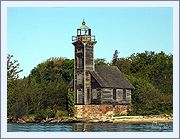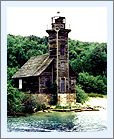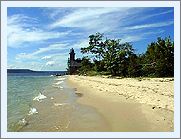 |
 |
 |
| Click thumbnails to view enlarged versions | ||
| Grand Island East Channel Light | Seeing The Light |
|
|
|
|
Historical Information
Congress responded with an appropriation of $6,000 in June of that same year for the construction of a pair of lighthouses to guide the passages. However, the Lighthouse Board found the funds insufficient for the job at hand, and requested an additional $10,000. The additional funds were finally appropriated in July 1866, and work on the Grand Island East Channel Light began the following year with the the clearing of the reservation on a sandy peninsula on the southeast shore of the island. As a result of the chosen site being both on low ground and close to the water's edge, a considerable amount of cribbing was installed along the shore line to help stave-off erosion and undermining of the station's foundation. Plans for the station building called-out a typical "schoolhouse" style combination dwelling and tower similar to that used frequently throughout the lakes. However, in order to minimize cost the building was to be of timber frame construction with wood siding, as opposed to the more common brick or stone materials used in such structures elsewhere. Painted white to increase its value as a daymark, the 1 ½ story dwelling incorporated a forty-five foot tower its southern end, and was outfitted with an oil-fired steamer lens with a focal plane of 49 feet.
It quickly became evident that the steamer lens was insufficient for the task, and the Eleventh Lighthouse District lampist arrived at the station in 1869 and replaced the steamer lens with a fixed white Fifth Order Fresnel lens, and modified the lantern's ventilation system to accommodate the hotter burning lens. With this modification, the effectiveness of the light was significantly increased, now being visible for a distance of 13 ¼ miles in clear condition. The combination of a wooden structure in such an exposed location, and its location on the low sandy area close to the water's edge created an ongoing maintenance nightmare for the district engineers, with the station listed as one at which considerable repairs were taken every year for the following thirty years. Finally, after some significant storms in 1899, the cribs were found to be so damaged that the station's foundation was in imminent danger of becoming undermined. The following year 262 feet of new cribbing, 8 feet high was installed and backed-up with 28 cords of stone. Finally, 311 feet of beach protection consisting of brush and stone were also added to further stem the incessant erosion.
To rectify the situation, 1904 the Lighthouse Board recommended that the sum of $13,200 be appropriated for the construction of a set of range lights in the town of Munising in its 1904 annual report. Expecting that lights so situated would serve as a direct guide through the eastern passage and lead vessels directly into the harbor of refuge, the Board further recommended that the old Grand Island East Channel Light be extinguished and abandoned on completion of the new range lights. With the receipt of Congressional approval in 1907, work began on the new Munising Range Lights the following year, and with their establishment on the night of October 30th, 1908, George Prior, the last keeper to serve at the East Channel Light removed his belongings from the station, and left the venerable structure to the elements.
Without any care throughout the years, the structure deteriorated rapidly. Without regular scraping and repainting, the once bright white structure had turned a dismal driftwood gray, and the cribs installed a hundred years previously had disintegrated completely, with the waters of Munising Bay lapping directly at the stones of the structure's foundation.
Concerned that without some immediate
action, the historic structure would be undermined and fall, a group of
local citizens came together to form the "East Channel Lights
Rescue Project," and began the process of identifying sources for
funds to construct some sort of shore protection. Among others, the
American Lighthouse Foundation stepped up to the plate, and with
sufficient funds to purchase materials, members of the Rescue Project
began the painstaking process of sinking cedar posts and gathering rocks
to form a protection in front of the lighthouse. This work continued
into 2001, and as a result of the relentless action of waves and ice,
will likely continue in perpetuity if the historic structure is to be
saved.
|